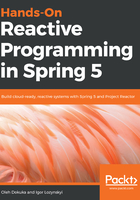
Message-driven communication
The only question that is left unclear is how to connect components in the distributed system and preserve decoupling, isolation, and scalability at the same time. Let's consider communication between components over HTTP. The next code example, doing HTTP communication in Spring Framework 4, represents this concept:
@RequestMapping("/resource") // (1)
public Object processRequest() {
RestTemplate template = new RestTemplate(); // (2)
ExamplesCollection result = template.getForObject( // (3)
"http://example.com/api/resource2", //
ExamplesCollection.class //
); //
... // (4)
processResultFurther(result); // (5)
}
The previous code is explained as follows:
- The code at this point is a request handler mapping declaration that uses the @RequestMapping annotation.
- The code declared in this block shows how we may create the RestTemplate instance. RestTemplate is the most popular web client for doing request-response communication between services in Spring Framework 4.
- This demonstrates the request's construction and execution. Here, using the RestTemplate API, we construct an HTTP request and execute it right after that. Note that the response will be automatically mapped to the Java object and returned as the result of the execution. The type of response body is defined by the second parameter of the getForObject method. Furthermore, the getXxxXxxxxx prefix means that the HTTP method, in that case, is GET.
- These are the additional actions that are skipped in the previous example.
- This is the execution of another processing stage.
In the preceding example, we defined the request handler which will be invoked on users' requests. In turn, each invocation of the handler produces an additional HTTP call to an external service and then subsequently executes another processing stage. Despite the fact that the preceding code may look familiar and transparent in terms of logic, it has some flaws. To understand what is wrong in this example, let's take an overview of the following request's timeline:

This diagram depicts the actual behavior of the corresponding code. As we may notice, only a small part of the processing time is allocated for effective CPU usage whereas the rest of the time thread is being blocked by the I/O and cannot be used for handling other requests.
On the other hand, in the Java world, we have thread pools, which may allocate additional threads to increase parallel processing. However, under a high load, such a technique may be extremely inefficient to process the new I/O task simultaneously. We will revisit this problem again during this chapter and also analyze it thoroughly in Chapter 6, WebFlux Async Non-Blocking Communication.
Nonetheless, we can agree that to achieve better resource utilization in I/O cases, we should use an asynchronous and non-blocking interaction model. In real life, this kind of communication is messaging. When we get a message (SMS, or email), all our time is taken up by reading and responding. Moreover, we do not usually wait for the answer and work on other tasks in the meantime. Unmistakably, in that case, work is optimized and the rest of the time may be utilized efficiently. Take a look at the following diagram:
- Non-Blocking (https://www.reactivemanifesto.org/glossary#Non-Blocking)
- Resource (https://www.reactivemanifesto.org/glossary#Resource)

In general, to achieve efficient resource utilization when communicating between services in a distributed system, we have to embrace the message-driven communication principle. The overall interaction between services may be described as follows—each element awaits the arrival of messages and reacts to them, otherwise lying dormant, and vice versa, a component should be able to send a message in the non-blocking fashion. Moreover, such an approach to communication improves system scalability by enabling location transparency. When we send an email to the recipient, we care about the correctness of the destination address. Then the mail server takes care of delivering that email to one of the available devices of the recipient. This frees us from concerns about the certain device, allowing recipients to use as many devices as they want. Furthermore, it improves failure tolerance since the failure of one of the devices does not prevent recipients from reading an email from another device.
One of the ways to achieve message-driven communication is by employing a message broker. In that case, by monitoring the message queue, the system is able to control the load management and elasticity. Moreover, the message communication gives clear flow control and simplifies the overall design. We will not get into specific details of this in this chapter, as we will cover the most popular techniques for achieving message-driven communication in Chapter 8, Scaling Up with Cloud Streams.
By embracing all of the previous statements, we will get the foundational principles of the reactive system. This is depicted in the following diagram:

As we may notice from the diagram, the primary value for any business implemented with a distributed system is responsiveness. Achieving a responsive system means following fundamental techniques such as elasticity and resilience. Finally, one of the fundamental ways to attain a responsive, elastic, and resilient system is by employing message-driven communication. In addition, systems built following such principles are highly maintainable and extensible, since all components in the system are independent and properly isolated.
All those notions are not new and have already been defined in the Reactive Manifesto, which is the glossary that describes the reactive system's concepts. This manifesto was created to ensure that businesses and developers have the same understanding of conventional notions. To emphasize, a reactive system and the Reactive Manifesto are concerned with architecture, and this may be applied to either large distributed applications or small one-node applications.